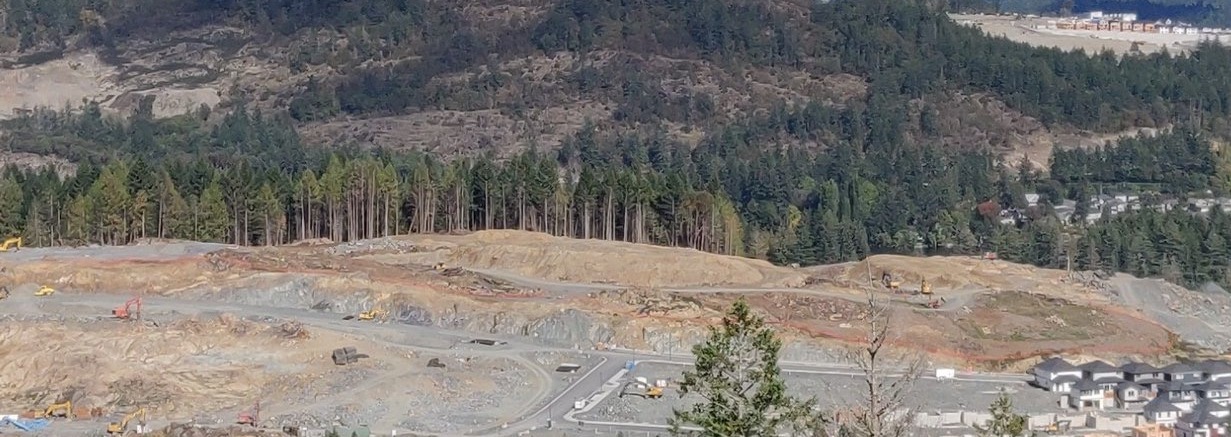
This is the final part in a four-part series to make as strong a case as possible for Missing Middle Housing in all neighbourhoods in Victoria. This initiative is key to the city’s future.
In a nutshell, Missing Middle Housing will allow for more inclusive housing forms “as of right”, which means without needing to go through a rezoning process. Missing Middle zoning will create more townhouses and houseplexes (including duplexes, triplexes, fourplexes, etc.) to help diversify housing choices. It’s aimed at people who will never be able to afford a single family home in Victoria.
Missing Middle Housing will also help to address climate change and contain urban sprawl by making homes available for families closer to the urban core. This reduces transportation emissions by locating housing within walkable and transit oriented locations, unlike the depiction in the photo above.
Fundamentally, Missing Middle Housing is about changing the way we regulate land use. Currently, if an owner of a single family home, or a duplex, or triplex wants to demolish that building and build a new single family home, all that is required is a building permit. Yet if a homeowner wants to demolish their single family home and build a houseplex, it takes a couple of years to go through a political process, with no guarantee of success.
Here’s how this has played out: the City approved fewer than 250 missing middle housing units between 2012 and 2019. By contrast, in the same period, the City approved over 600 units in the form of single-family dwellings or suites therein.
And, a current market update presented by the Condo Group at a recent Urban Development Institute webinar shows the dearth of supply when it comes to townhomes, not only in Victoria but also across the region.

“Months of supply” is a calculation that quantifies the relationship between supply and demand in a housing market. It quantifies how many months it would take the market (in its current condition) to absorb the entire active inventory. A healthy housing market has between four and six months of supply available. The 0.6 months of supply for townhomes across the region is extremely concerning. Developers have the advantage in this situation, as they can charge a premium on new townhouse units, because there is virtually no competition.
More Inclusive Cities
But this lack of supply puts young families and others seeking to afford to purchase a home in the the city at a disadvantage. Census data shows that Victoria continues to lose young families with children to the suburbs. This is worrisome when thinking about inclusion, but it’s also a public health and well-being issue. Census data also shows that Victoria leads Canada’s mid-sized cities in walking and cycling to work. There are health benefits to being able to afford to buy a home in the city.
In a previous blog post, I’ve laid out the efforts the City is making to create more truly affordable housing for those who are struggling just to make ends meet. Since publishing that post, Council has taken a step forward to make affordable housing (run by non-profit housing operators, co-ops, or government agencies) as of right anywhere in the city, as long as it fits with the City’s Official Community Plan. The final step in that policy change is a public hearing sometime in the next couple of months.
As noted in the post on the housing affordability crisis, unlike the City’s other housing policies, Missing Middle Housing won’t create affordable housing for very low, low and moderate income earners. But it will make home ownership more attainable for more working people in the city. This is also an important objective if we want to have a healthy, diverse community, and a strong economy. Many businesses are having trouble filling jobs and attracting people to Victoria because housing is too expensive, even for working professionals.
The Victoria Real Estate Board’s past decade of data shows that townhouses have continued to cost 20% less than a single-family dwelling in Victoria. Prezoning land through the Missing Middle Housing initiative can help bring the costs of townhomes and houseplexes down even lower.
Here’s how:
The City of Victoria’s planning staff have identified alignment between the City’s Missing Middle Housing initiative and the provincial Housing Hub’s Affordable Home Ownership Program (AHOP), as well as other provincial priorities, including affordability, accessibility, and CleanBC objectives.
Having Missing Middle Housing forms allowed as of right / without a rezoning process required substantially de-risks these projects from a provincial financing point of view. Provincial programs through AHOP could increase the proportion of missing middle units sold at below market prices, including three-bedroom units.
For example, on a potential sixplex project, an AHOP program partnership could translate into an estimated savings of $50-$90K on the purchase price of each below market housing unit. Combined with AHOP’s second mortgage equity support, AHOP program partnership contributions could help couples with children and other households purchase a home in a missing middle project.
Facilitating the creation of more Missing Middle Housing in Victoria improves the availability of critically lacking housing choices, including three-bedroom homes for young families and homes that support aging in place and accessibility. This will help create more inclusive neighbourhoods and a more inclusive city.
Climate Friendly Cities
In 2020, the South Island Prosperity Partnership and the City of Victoria commissioned a series of reports from The Business of Cities to understand how Victoria and the region measured against peer cities globally. We wanted to understand our strengths, opportunities and threats from a global perspective, coming out of the pandemic.
In the report, “Global Benchmarking: Putting Greater Victoria’s Economy in International Perspective,” I was alarmed to read the author’s assessment that, “Greater Victoria’s efforts to preserve natural assets have on the whole been less successful.” The authors note that, “From 2004 to 2018, the proportion of natural land surfaces and tree covered areas declined by around 2%, putting Greater Victoria in the middle of the pack relative to its wider peer group for preservation of natural assets … [this] represents a long-term threat to the region’s resilience to natural and climate change disasters.”
The researchers didn’t map the degradation of natural assets. But we can do that ourselves, driving out of town on Highway 1, where single family homes now stand where forests once did.
Making better use of Victoria’s land base and making more room for more people at more attainable housing prices will slow down deforestation and urban sprawl. Missing Middle Housing is critical to our city and region’s ability to successfully weather climate change.
The author of The Death and Life of the Single-Family House: Lessons from Vancouver on Building a Livable City, doesn’t mince words in his assessment of the negative impact of single family homes on the environment. In an interview he said, “With respect to the environment, the development of single-family houses directly consumes an enormous amount of land for suburban or ex-urban style sprawl, disrupting and displacing prior ecologies. By virtue of sprawl, houses also encourage people to drive everywhere, boosting greenhouse gas emissions. Moreover, houses generally require more energy to heat and cool than other types of dwelling, further leading to greater greenhouse gas emissions. Just about any way you look at it, single-family houses tend to be bad for the environment.” (The whole interview is definitely worth a read!)
Let me be very clear: this doesn’t mean that people who live in single family homes don’t care about the environment. After my first post on Missing Middle Housing, about the racist and exclusionary history of single family zoning, there were some people who felt I was saying that people who live in single family homes are racist, so it’s worth clarifying here.
What I am saying, however, is that we are at a pivotal moment in the future of the city and in our ability to prepare for the challenges coming our way with climate change. If we know that single family homes are the least energy efficient form of housing, then we should change our zoning rules to make it easier to build more efficient housing types.
Let’s look at the energy use of different building types in more detail, and also the impact of location on energy consumption.
In 2009, in the US the Environmental Protection Agency, U.S. Department of Housing and Urban Development (HUD), and U.S. Department of Transportation formed a partnership for Sustainable Communities. A key research paper produced through this partnership examined the energy efficiency of both housing form and housing location – comparing compact, transit-oriented development against conventional suburban development.
The results are striking. They strengthen the case for Missing Middle Housing and also for greater density in regional cores like Victoria, if we are serious about climate mitigation and preparing for a resilient future.

This graph shows clearly that single family attached homes – like rowhouses, houseplexes and townhouses – consume less energy than single family homes. And, when located in transit-oriented, “15-minute neighbourhoods,” the energy savings are even more substantial. In our region, transportation accounts for 50% of greenhouse gas emissions, and buildings generate 40% of greenhouse gas emissions. Missing Middle Housing in Victoria can go some way to addressing these impacts.
Conclusion
After two rounds of in-depth public engagement, the next step in the City’s Missing Middle Housing initiative is for staff to bring a report for Council’s consideration. At that meeting, Council will decide whether or not to hold a public hearing, before making a final decision on Missing Middle zoning. My hope is that even the councillors who may not be fully supportive of the initiative at this time vote to hold a public hearing on the matter, so we can hear from the public on the most important land-use decision a Victoria City Council has made in decades.
We will surely hear lots of stories at the public hearing from people who feel they will lose something if Council proceeds with Missing Middle housing – most notably a fear of losing neighbourhood character. If this is your concern, please read this post. We will also hear from people who will benefit from these changes, and about their fears of being priced out of the city if Council doesn’t adopt Missing Middle zoning.
We will need to consider all of the input. And, we will also need to fulfill our responsibility to think about the long term. We are not only making a decision for now, and for the people in the Council chamber on the evening of the public hearing. We are also making a decision for their children and their grandchildren, a decision for the next 50 years.





